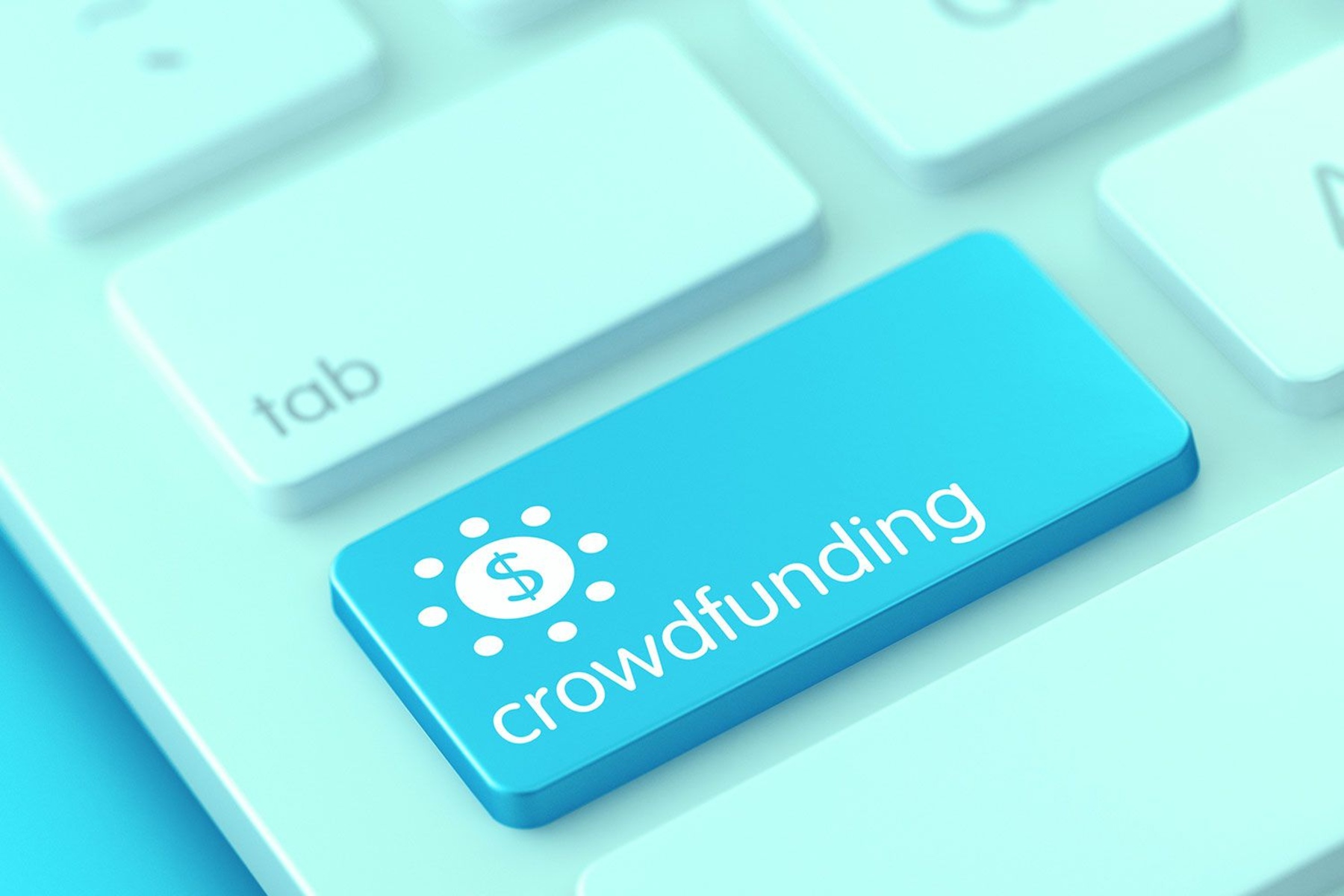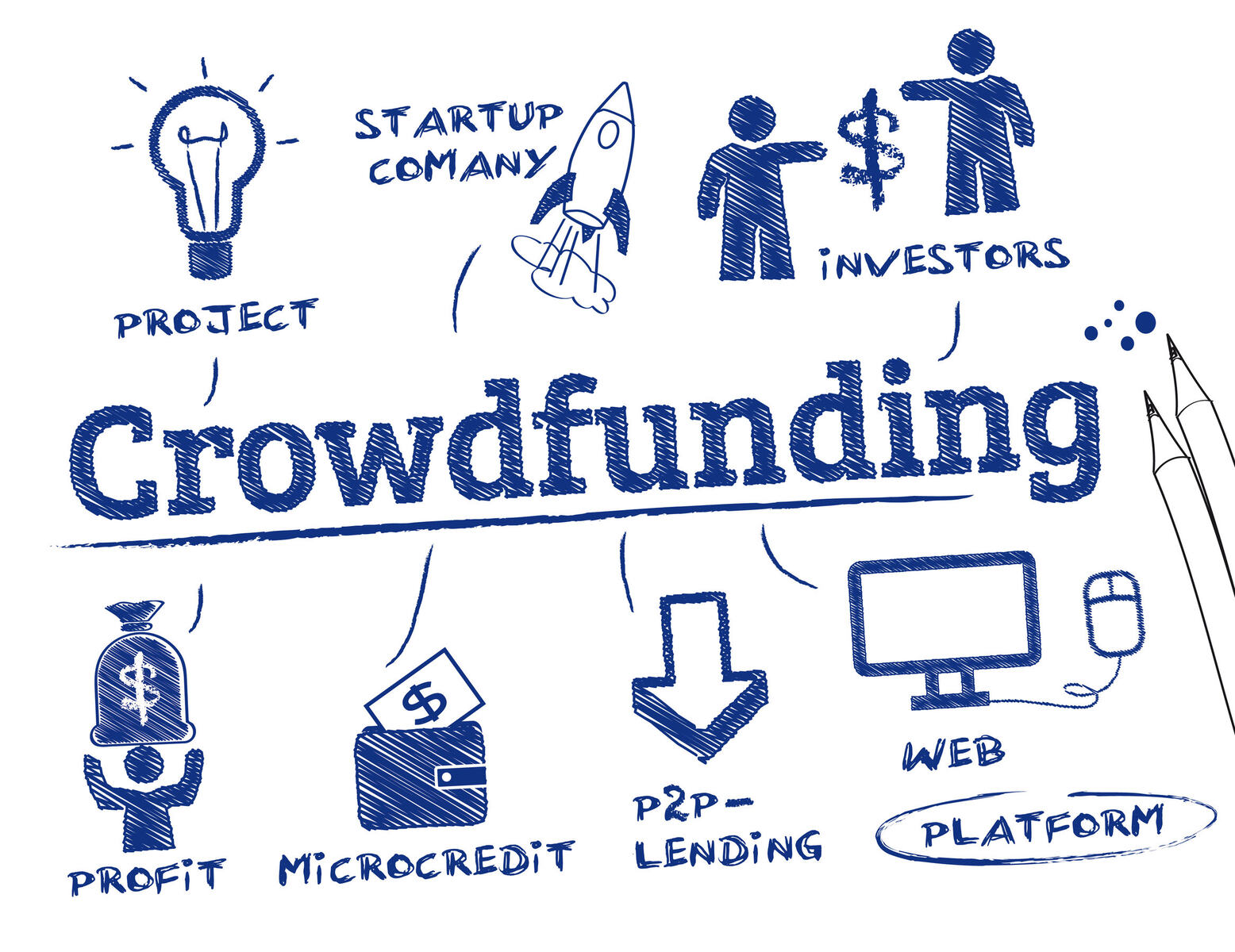Introduction
Welcome to the world of crowdfunding! If you have ever had a brilliant business idea or a project you are passionate about, but lacked the funds to bring it to life, crowdfunding can be the answer you’ve been looking for. Crowdfunding has become an increasingly popular method for entrepreneurs, artists, and individuals to raise money and gain support from a large pool of backers.
Crowdfunding is an innovative approach that utilizes the power of the internet and social networks to connect creators with potential investors or donors. It offers a unique opportunity for individuals and businesses to gather financial support from a wide range of people who believe in their idea or cause.
But what exactly is crowdfunding and how does it work? In this article, we will explore the definition of crowdfunding and its various types, as well as provide you with a step-by-step guide on how to launch a successful crowdfunding campaign.
So, whether you are an entrepreneur looking to kickstart your next business venture, an artist seeking funds for your latest creative project, or an individual in need of financial assistance for a personal cause, crowdfunding can be the platform that turns your dreams into reality.
Join us as we delve into the exciting world of crowdfunding and discover how this innovative concept is reshaping the way we fund and support ideas, projects, and causes.
How is crowdfunding defined?
Crowdfunding, in simple terms, refers to the practice of raising funds for a project, business, or cause through small contributions from a large number of people, usually via an online platform. It allows individuals, entrepreneurs, and organizations to bypass traditional funding avenues and directly connect with potential backers or investors who are interested in supporting their venture.
At its core, crowdfunding is a collaborative effort that brings together creators and supporters, enabling them to collaborate and collectively bring ideas to life. It transforms the way we perceive fundraising by democratizing access to capital and empowering individuals to reach their goals.
One defining characteristic of crowdfunding is its reliance on technology and the internet. Online platforms serve as the digital marketplaces where creators can showcase their projects, outline their funding goals, and engage with a global audience. These platforms provide a space for creators to present their ideas effectively and for backers to discover and support projects aligned with their interests.
An essential aspect of crowdfunding is the incentive provided to backers. Depending on the type of crowdfunding, backers may receive various rewards and benefits in exchange for their financial support. This can range from receiving early access to a product, exclusive perks, or even a share of equity in the case of equity crowdfunding.
Furthermore, crowdfunding is not limited to any particular industry or sector. It has gained popularity across a wide range of fields, including technology, arts and culture, social causes, business startups, and even personal projects. This versatility allows for a diverse array of ideas and ventures to come to fruition, irrespective of traditional funding limitations.
Overall, crowdfunding is a transformative financing model that enables ordinary individuals to become part of the funding process and contribute to projects that resonate with them. It offers a powerful alternative to traditional funding methods, challenging the conventional notions of who can access capital and what ideas are deemed worthy of support.
Types of crowdfunding
There are several different types of crowdfunding, each catering to specific needs and goals. Whether you are looking to launch a new product, raise funds for a charitable cause, or secure investments for your business, understanding the various types of crowdfunding can help you determine the most suitable approach for your project. Here are some of the most common types of crowdfunding:
- Rewards-based crowdfunding: This is the most popular type of crowdfunding and involves offering rewards or perks to backers who contribute financially to your project. These rewards can be tangible, such as a product sample, or intangible, such as special access to exclusive content. Backers contribute funds with the expectation of receiving the promised rewards once the project is successfully funded.
- Equity crowdfunding: Equity crowdfunding allows individuals to invest in a company in exchange for equity or shares. Instead of receiving rewards, backers become shareholders and have the potential for financial returns if the company succeeds. This type of crowdfunding is particularly popular for startups and small businesses seeking capital investors.
- Donation-based crowdfunding: Donation-based crowdfunding is focused on raising funds for charitable causes or personal needs. It relies on the goodwill of individuals who contribute without expecting any financial returns or rewards. This type of crowdfunding is commonly used for medical expenses, disaster relief efforts, community projects, and non-profit organizations.
- Debt crowdfunding: Debt crowdfunding, also known as peer-to-peer lending or crowdlending, involves individuals lending money to others with the expectation of receiving repayment with interest. This type of crowdfunding bypasses traditional financial institutions, allowing individuals to borrow money directly from a pool of lenders.
Each type of crowdfunding has its advantages and considerations. When choosing the right type for your project, consider your funding goals, the nature of your project, and the potential benefits and risks associated with each approach. It’s important to thoroughly research and understand the platform and legal requirements associated with the chosen crowdfunding type.
Now that you have gained an overview of the different types of crowdfunding available, let’s dive into the specifics of how crowdfunding works and the steps to launch a successful crowdfunding campaign.
Rewards-based crowdfunding
Rewards-based crowdfunding is the most common type of crowdfunding, where creators offer rewards or perks to backers in exchange for their financial contributions. This model allows creators to generate revenue while providing backers with an incentive to support the project. Rewards can vary from project to project and can be tangible items, exclusive experiences, or special acknowledgments.
Creators typically set different reward tiers, with higher-tier rewards given to backers who contribute more funds. For example, a music artist may offer digital downloads of their album for lower-tier backers, signed CDs for mid-tier backers, and exclusive VIP concert tickets for top-tier backers.
One of the benefits of rewards-based crowdfunding is that it creates a sense of community and engagement between the creator and backers. Backers not only provide financial support but become a part of the project’s success. They feel invested in the journey and are motivated to help the project reach its funding goal.
When launching a rewards-based crowdfunding campaign, it is crucial to carefully plan and organize the rewards offered. The rewards should be enticing and valuable to the backers while also being realistic and achievable for the creator. Balancing the cost of rewards with the funds raised is essential to ensure the project remains financially feasible.
Additionally, creators need to communicate effectively with their backers throughout the campaign. Providing regular updates, showcasing progress, and expressing gratitude to backers can foster a stronger sense of community and encourage ongoing support. Maintaining open and transparent communication helps build trust and credibility, which is vital for the success of the campaign.
Another key aspect of rewards-based crowdfunding is setting a funding goal and timeline. Creators must determine the amount of money required to bring their project to fruition. It is important to set a realistic funding goal that covers the costs of production, manufacturing, marketing, and any other associated expenses. Furthermore, setting a timeline for the campaign helps create a sense of urgency and motivates backers to contribute.
Creators often choose popular crowdfunding platforms, such as Kickstarter and Indiegogo, to host their rewards-based campaigns. These platforms provide a ready-made audience of potential backers and offer the necessary tools and support for managing and promoting the campaign.
Overall, rewards-based crowdfunding provides creators with an opportunity to not only secure the necessary funding for their projects but also engage with their audience and build a loyal community. By offering unique rewards and fostering a sense of connection, creators can successfully raise funds and turn their ideas into reality.
Equity crowdfunding
Equity crowdfunding is a type of crowdfunding that allows individuals to invest in a company or startup in exchange for equity or shares. Unlike rewards-based crowdfunding, where backers receive non-financial rewards, equity crowdfunding offers the potential for financial returns if the company succeeds.
This type of crowdfunding has gained significant popularity as it provides individuals with an opportunity to invest in early-stage businesses and startups that they believe have promising growth potential. Additionally, it allows companies to raise capital from a broad pool of investors who are interested in supporting innovative ventures.
Equity crowdfunding operates through online platforms that facilitate the connection between companies seeking funding and potential investors. These platforms usually have legal and regulatory requirements in place to protect both parties and ensure compliance with securities laws.
Investors who participate in equity crowdfunding become shareholders in the company, holding a stake or ownership interest. The level of shares held is determined by the amount invested. As the business grows and prospers, investors may benefit from dividends or see an increase in the value of their shares. Conversely, if the business fails, investors may risk losing their invested capital.
Equity crowdfunding provides several advantages for both companies and investors. From a company’s perspective, it offers an alternative to traditional funding avenues such as bank loans or venture capital investments. It allows businesses to maintain control over their operations and strategies while gaining access to funds necessary for growth.
For investors, equity crowdfunding presents opportunities to diversify their investment portfolios, support emerging businesses, and potentially benefit from high returns if the company becomes successful. It offers a chance to be part of the entrepreneurial journey and contribute to the growth of innovative ideas.
However, it is important to understand the risks associated with equity crowdfunding. As with any investment, there is no guarantee of returns, and investors should carefully assess the potential risks and rewards before participating. It is advisable to thoroughly research the company, its business model, market conditions, and the legal framework surrounding equity crowdfunding.
Equity crowdfunding is subject to specific regulations and requirements, which vary depending on the country or jurisdiction. It is essential for both companies and investors to ensure compliance with these regulations to protect their interests.
In summary, equity crowdfunding enables individuals to invest in businesses and startups in exchange for equity or shares. It presents an exciting opportunity for investors to support innovative ventures while potentially benefiting from financial returns. For companies, equity crowdfunding offers an alternative method of raising capital and engaging with a diverse group of investors who share their vision for growth.
Donation-based crowdfunding
Donation-based crowdfunding is a type of crowdfunding that focuses on raising funds for charitable causes or personal needs. Unlike rewards-based or equity crowdfunding, donation-based crowdfunding does not involve providing financial returns or rewards to backers. Instead, individuals contribute funds out of goodwill and a desire to support a cause they believe in.
This type of crowdfunding has become a popular method for individuals, non-profit organizations, and communities to rally support and gather financial assistance for various purposes. It enables individuals to reach out to a vast network of potential donors who can contribute small or large amounts, collectively making a significant impact.
Donation-based crowdfunding campaigns are usually associated with initiatives such as medical expenses, disaster relief efforts, community projects, education, arts and culture, and other social causes. It allows individuals and organizations to mobilize resources quickly and efficiently, bypassing traditional funding channels and connecting directly with those who are willing to contribute.
One of the key benefits of donation-based crowdfunding is its ability to create a sense of unity and collective action. It gives people an opportunity to come together and make a meaningful difference in the lives of others or in addressing social issues. By leveraging the power of the internet and social media, donation-based crowdfunding amplifies the reach and impact of these campaigns.
When launching a donation-based crowdfunding campaign, it is essential to clearly communicate the purpose and objectives of the campaign. The campaign should provide a compelling narrative and explain why the cause is worthy of support. Sharing engaging stories, images, and videos can help create an emotional connection with potential donors and inspire them to contribute.
Transparency and accountability are crucial in donation-based crowdfunding. Donors want reassurance that their funds will be used for the intended purpose. It is important for campaign organizers to be transparent about how the funds will be utilized and provide regular updates on the progress and impact of the campaign. Building trust with donors is essential for the success and longevity of the campaign.
Donation-based crowdfunding platforms, such as GoFundMe and Kickstarter’s Public Good category, provide the infrastructure and support necessary for individuals and organizations to launch and manage their campaigns. These platforms offer tools for sharing campaign updates, processing donations securely, and promoting the campaign to a wider audience.
In summary, donation-based crowdfunding is a powerful tool for individuals and organizations to raise funds for charitable causes or personal needs. It harnesses the collective goodwill of people to make a positive impact and drive social change. By utilizing online platforms and effective storytelling, donation-based crowdfunding provides a platform for individuals and communities to come together and support causes that resonate with their values.
Debt crowdfunding
Debt crowdfunding, also known as peer-to-peer lending or crowdlending, is a type of crowdfunding that allows individuals or businesses to borrow money from a pool of lenders. Unlike other forms of crowdfunding, where backers receive rewards or equity, debt crowdfunding involves a contractual agreement for repayment with interest over a specified period.
This form of crowdfunding has gained popularity as an alternative to traditional lending methods. It allows borrowers to access capital outside of traditional financial institutions, and lenders to invest their money and earn interest directly from borrowers.
The process of debt crowdfunding typically involves a lending platform that connects borrowers and lenders. Borrowers create loan listings, outlining the purpose of the loan, the requested amount, and the interest rate they are willing to pay. Lenders can then review these listings and choose to fund the loans they find suitable.
Debt crowdfunding offers advantages for both borrowers and lenders. For borrowers, it provides an avenue to secure financing for various purposes such as business expansion, debt consolidation, or personal needs. Borrowers may find debt crowdfunding more accessible and flexible compared to traditional loans, especially if they have limited credit history or face challenges obtaining loans from banks.
On the other hand, lenders benefit from debt crowdfunding by diversifying their investment portfolios and potentially earning higher interest rates than traditional savings or investment vehicles. Lenders have the opportunity to select the loans they want to fund based on their risk tolerance and desired returns.
Debt crowdfunding platforms typically assess the creditworthiness of borrowers using various criteria, such as credit scores, financial history, and the purpose of the loan. This evaluation helps lenders make informed decisions and reduces the risk associated with lending.
It is important for both borrowers and lenders to carefully consider the terms and conditions of the loan before participating in debt crowdfunding. Borrowers should assess their ability to repay the loan and ensure that the interest rates and repayment schedule are manageable. Lenders should evaluate the risk associated with each loan listing and diversify their investments across multiple loans to minimize potential losses.
Debt crowdfunding is subject to applicable regulations and legal requirements in different jurisdictions. Lending platforms usually have guidelines in place to ensure compliance and protect the interests of both borrowers and lenders.
In summary, debt crowdfunding offers an alternative method of borrowing and lending money outside of traditional financial institutions. It provides opportunities for borrowers to access funds and lenders to earn interest on their investments. By connecting borrowers and lenders through dedicated platforms, debt crowdfunding provides a mutually beneficial arrangement that bypasses traditional lending channels.
How does crowdfunding work?
Crowdfunding is a process that involves several key steps and elements to successfully raise funds for a project, business, or cause. Understanding how crowdfunding works can help individuals and organizations navigate the process and increase their chances of reaching their funding goals. Here are the essential steps involved:
- Identify your funding goals: Begin by defining the purpose of your crowdfunding campaign and determining how much money you need to achieve your objectives. This includes identifying the specific expenses, production costs, or milestones that the funds will be used for.
- Choose a crowdfunding platform: Research and select a suitable crowdfunding platform that aligns with your project or cause. Consider factors such as the platform’s reach, fee structure, user-friendly interface, and available support and resources.
- Prepare a compelling campaign: Create a compelling and persuasive campaign that clearly communicates the purpose of your project, the impact it will have, and why people should support it. Utilize storytelling techniques, visuals, and engaging content to captivate potential backers.
- Set up your crowdfunding campaign: Once you have chosen a platform, create your campaign page. This involves providing detailed information about your project, setting a funding goal, creating reward tiers (if applicable), and establishing a timeline for your campaign.
- Promote your campaign: Spread the word about your crowdfunding campaign through various marketing channels and strategies. Utilize social media, email marketing, content creation, and partnerships to reach a wider audience and generate buzz around your project. Engage with potential backers, answer their questions, and encourage them to share your campaign with their networks.
- Encourage backers to contribute: Offer incentives and rewards for backers, depending on the type of crowdfunding you have chosen. Provide attractive rewards that align with the contribution levels and values of your target audience. Regularly update your backers on the progress of your campaign to maintain their interest and engagement.
- Reach your funding goal: As backers contribute to your campaign, monitor your progress closely. Continuously engage with your audience to build momentum and encourage more support. If possible, consider implementing stretch goals to incentivize further contributions beyond your initial funding target.
- Deliver on your promises to backers: Once your campaign successfully reaches its funding goal, it’s crucial to deliver on the promises made to your backers. Ensure that you fulfill rewards, provide updates on the progress of your project, and maintain open communication with your community of supporters.
By following these steps and utilizing effective marketing and communication strategies, you can increase the chances of a successful crowdfunding campaign. Crowdfunding offers a unique opportunity to access funds and support from a diverse community of backers who believe in your project or cause. Embrace the power of crowdfunding to bring your ideas to life and make a meaningful impact.
Identify your funding goals
Before launching a crowdfunding campaign, it is crucial to clearly identify your funding goals. Understanding the specific financial needs of your project or cause will not only help you set realistic targets but also enable you to effectively communicate them to potential backers. Here are some key factors to consider when identifying your funding goals:
Costs and expenses: Start by assessing the expenses associated with your project or cause. Break down the costs into various components such as production, materials, marketing, personnel, and any other necessary investments. Be thorough and realistic in estimating these expenses to ensure that you set an achievable funding goal.
Milestones and objectives: Determine the milestones or objectives that you aim to achieve with the funds raised. This could include reaching a certain production stage, launching a new product or service, expanding into new markets, or scaling up operations. Having clear milestones not only helps you define your funding needs but also provides a tangible sense of progress for your backers.
Contingency and buffer: It’s often wise to include a contingency or buffer amount in your funding goal to account for any unforeseen expenses or challenges that may arise during the course of your project. Unexpected circumstances can occur, and having a safety net in your funding goal can help you navigate such situations without derailing your progress.
Research and market analysis: Conduct thorough research and market analysis to understand the current landscape and demand for your project or cause. This will help you determine an appropriate funding goal that aligns with the market and the resources needed to achieve your desired outcomes. Consider factors such as competitors, target audience, market size, and pricing strategy in your analysis.
Realistic expectations: While it’s important to set ambitious goals, ensure that your funding goal is realistic and attainable. Assess the potential interest and support for your project or cause based on the market and audience research. Be transparent about the use of funds and provide a breakdown of how the money will be allocated.
Communicating your funding goals: Clearly communicate your funding goals to potential backers by articulating the impact their contributions will make. Describe how the funds will be used, the positive outcomes that will be achieved, and the benefits to your supporters. This will help potential backers understand the value and significance of their contributions.
Stretch goals: Consider incorporating stretch goals into your funding strategy. These are additional funding milestones beyond your initial goal that can be unlocked as your campaign progresses. Stretch goals can incentivize backers to continue supporting your campaign and contribute more, as they provide an opportunity to unlock additional features, rewards, or enhanced outcomes.
By taking the time to clearly identify your funding goals and communicate them effectively, you can inspire confidence and trust in potential backers. Remember to regularly assess and evaluate your funding goals as your campaign progresses, making adjustments if necessary to ensure continued success.
Choose a crowdfunding platform
Choosing the right crowdfunding platform is a critical decision that can greatly impact the success of your campaign. With numerous platforms available, each offering unique features and benefits, it’s important to carefully consider your project’s needs and objectives. Here are some factors to consider when selecting a crowdfunding platform:
Platform focus and niche: Different crowdfunding platforms cater to specific niches or industries. Some platforms focus on creative projects, while others specialize in social causes, technology startups, or small businesses. Research platforms that align with your project’s category or niche to ensure you have access to a relevant audience of potential backers.
Platform reach and user base: Consider the size and reach of the platform’s user base. A larger user base can provide access to a larger pool of potential backers, increasing the visibility and exposure of your campaign. Platforms with an established reputation and a strong user community can help amplify your campaign’s reach through their existing network.
Platform fees and costs: Review the fee structures of different platforms to understand the costs involved in running your campaign. Crowdfunding platforms typically charge a percentage fee for the funds raised, and some may have additional fees for certain features or services. Compare the fees of different platforms and assess how they align with your funding goals and budget.
User-friendly interface: Evaluate the user experience and interface of the crowdfunding platforms you are considering. A user-friendly platform will make it easier for both you as the campaign owner and potential backers to navigate and engage with your campaign. Look for platforms that offer intuitive campaign creation tools, customization options, and easy payment processing.
Platform support and resources: Consider the level of support and resources provided by the crowdfunding platform. Some platforms offer educational materials, campaign optimization tips, and dedicated support teams to assist you throughout your campaign. Access to valuable resources and expert guidance can significantly enhance the success of your campaign.
Success stories and track record: Research the success stories and track record of previous campaigns on the platform. Look for projects similar to yours that have achieved their funding goals and assess the platform’s ability to support projects in your category. A platform with a track record of successful projects indicates a favorable environment for your campaign.
Platform rules and regulations: Familiarize yourself with the rules and regulations imposed by the platform. Each platform will have its own terms of service, guidelines, and requirements that you need to adhere to. Ensure your project aligns with the platform’s policies and that you understand the obligations and restrictions associated with using the platform.
Community engagement and social features: Evaluate the platform’s community engagement features and social sharing capabilities. Platforms that prioritize social interaction and provide tools for backers to easily share campaigns can help increase your campaign’s visibility and reach. Look for platforms that foster an active and engaged community around crowdfunding campaigns.
By thoroughly researching and considering these factors, you can choose a crowdfunding platform that best aligns with your project’s needs and increases your chances of a successful campaign. Remember, the platform you choose serves as the foundation for your crowdfunding journey, so select one that provides the right combination of reach, support, and resources to help you achieve your funding goals.
Prepare a compelling campaign
A compelling and well-prepared crowdfunding campaign is crucial for capturing the attention and support of potential backers. It’s essential to craft a campaign that effectively communicates your project’s purpose, resonates with your target audience, and motivates them to contribute. Here are some key steps to prepare a compelling campaign:
Create a captivating story: Craft a compelling narrative that highlights the importance and impact of your project. Your story should engage potential backers on an emotional level, inspiring them to connect with your mission and support your campaign. Communicate your passion, the problem your project addresses, and why it matters.
Define your project’s unique value proposition: Clearly articulate the unique value proposition of your project and how it differentiates itself from others. Explain what makes your project special, the benefits it offers, and why people should choose to support it. Convey the value that backers will receive by contributing to your campaign.
Utilize visuals and media: Enhance your campaign with high-quality visuals, including photos, videos, graphics, and infographics. Visual elements grab attention, provide context, and help potential backers better understand your project. Incorporate visuals that showcase your product, demonstrate the impact of your cause, or illustrate the journey of your project.
Set clear and attainable goals: Clearly define the goals and outcomes you aim to achieve with the funds raised. Outline the specific metrics or milestones tied to these goals and explain how the funds will be utilized. This clarity and transparency give backers a clear understanding of how their contributions will make a difference.
Offer enticing rewards: Develop a range of appealing and meaningful rewards for different contribution levels. The rewards should align with your project and resonate with your target audience. Consider exclusive behind-the-scenes content, early access to products, limited editions, personalized experiences, or recognition in project-related materials.
Create a sense of urgency: Establish a clear timeline for your campaign and emphasize the urgency of backing your project. Highlight any time-limited offers or early bird incentives to encourage potential backers to act swiftly. Regularly update your campaign with progress updates and milestones to create a sense of momentum and urgency.
Craft a compelling pitch video: A pitch video can be a powerful tool to introduce your project and connect with potential backers. Use the video to captivate viewers, share your story, and highlight the key elements of your campaign. Keep the video concise, engaging, and authentic to effectively convey your message.
Share testimonials and social proof: Include testimonials, endorsements, or reviews from individuals who have experienced or supported your project in the past. Social proof can help build credibility and trust among potential backers, showing that others have seen value in your project and believe in its success.
Create a visually appealing campaign page: Design an attractive and user-friendly campaign page that showcases your project effectively. Use engaging headlines, clear sections, and strategic formatting to make the information easily digestible. Ensure that the campaign page represents your project’s visual branding and matches the overall tone of your campaign.
By following these steps and crafting a compelling campaign, you can capture the attention and interest of potential backers. Remember to continuously refine and optimize your campaign materials based on feedback and insights from your target audience. A well-prepared campaign will ignite excitement and inspire support, increasing your chances of reaching your crowdfunding goals.
Set up your crowdfunding campaign
Setting up your crowdfunding campaign is a crucial step in bringing your project to life. A well-structured and thoughtfully planned campaign page will effectively convey your message and motivate potential backers to support your project. Here are the key steps to set up your crowdfunding campaign:
Choose a suitable crowdfunding platform: Select a crowdfunding platform that aligns with your project’s objectives and target audience. Consider factors such as platform reach, user base, fees, and available features. Popular platforms like Kickstarter, Indiegogo, and GoFundMe offer user-friendly interfaces and a wide reach.
Create a captivating campaign title: Craft a concise and compelling campaign title that grabs attention and conveys the essence of your project. A catchy title can intrigue potential backers and entice them to learn more about your campaign.
Write an attention-grabbing campaign description: Craft a captivating campaign description that clearly and concisely conveys the purpose, benefits, and impact of your project. Start with a compelling hook to pique interest and use persuasive language to engage readers. Clearly explain why your project matters and how it will make a difference.
Use compelling visuals: Incorporate eye-catching visuals, such as high-quality images and videos, to enhance your campaign page. Visuals help potential backers visualize your project and build an emotional connection. Showcase your product, demonstrate the impact of your cause, or share the journey behind your project.
Set a realistic funding goal: Determine a funding goal that realistically aligns with the funds required to bring your project to fruition. Take into account the costs of production, manufacturing, marketing, and any other associated expenses. A transparent and reasonable funding goal helps instill confidence in potential backers.
Define your reward tiers: Offer attractive and meaningful rewards at different donation levels to incentivize potential backers. The rewards should align with your project and cater to the interests of your target audience. Consider offering exclusive merchandise, early access to products, or personalized experiences.
Create a timeline: Establish a timeline for your campaign to create a sense of urgency and motivate backers to take action. Outline key milestones, such as early bird discounts or limited-time rewards, to drive engagement and encourage early support. Continuously update your campaign page with progress updates to maintain momentum.
Develop a marketing and promotion strategy: Devise a comprehensive marketing and promotion plan to generate awareness and attract potential backers. Utilize social media, email marketing, content creation, influencer partnerships, and press releases to spread the word about your campaign. Engage with your target audience and encourage them to share your campaign with their networks.
Provide transparency and updates: Be transparent about how you will use the funds raised and provide regular updates to your backers. Keep them informed about the progress of the project, any challenges or milestones achieved, and how their contributions are making a difference. Regular communication builds trust and engages supporters.
Create a sense of credibility: Enhance your campaign page’s credibility by sharing relevant information about yourself or your team. Highlight your expertise, past achievements, or qualifications that demonstrate your ability to execute the project successfully. This helps potential backers feel confident in supporting your campaign.
Optimize your campaign for searchability: Utilize appropriate keywords, tags, and categories to optimize the discoverability of your campaign on the crowdfunding platform and search engines. Optimize your campaign description and headlines to attract relevant traffic and improve your chances of being found by potential backers.
By following these steps and putting effort into setting up your crowdfunding campaign, you can create an attractive and engaging campaign page that captures the attention and support of potential backers. Remember to keep your campaign page regularly updated and maintain strong communication with your backers throughout the campaign.
Promote your campaign
Once your crowdfunding campaign is set up, the next crucial step is to promote it effectively. Promoting your campaign is essential to generate awareness, engage potential backers, and drive contributions. Here are some key strategies to promote your crowdfunding campaign:
Utilize social media: Leverage the power of social media platforms to promote your campaign to a wide audience. Create engaging posts, share updates, and use relevant hashtags to increase visibility. Engage with your followers, respond to comments, and encourage sharing to expand your reach.
Tap into your personal network: Start by reaching out to your friends, family, and colleagues. Ask them to support your campaign and share it within their networks. Personal connections can be the initial driving force behind your campaign’s success and help create momentum.
Create captivating content: Develop compelling content related to your campaign such as blog posts, infographics, videos, or podcasts. Offer valuable insights, share behind-the-scenes footage, or tell stories that connect with your target audience. Distribute this content through various channels to attract attention and spark interest.
Collaborate with influencers: Identify influencers or bloggers who align with your project or cause. Collaborate with them to share your campaign with their followers. Influencers can provide an additional boost to your campaign’s visibility and credibility.
Engage with online communities: Participate in relevant online communities, forums, or social media groups where your target audience gathers. Contribute valuable insights, answer questions, and share your campaign when appropriate. However, be mindful to respect the community guidelines and avoid spamming.
Reach out to media outlets: Draft a press release highlighting the unique aspects of your project and share it with relevant media outlets, bloggers, and journalists. Seek opportunities for interviews or feature stories that can give your campaign additional exposure.
Host events or webinars: Organize events or webinars related to your project or cause. Provide valuable content, showcase your project, and engage with participants. You can leverage these events to promote your campaign, answer questions, and build connections with potential backers.
Implement email marketing: Build an email list of interested individuals who want to stay updated about your campaign. Send regular newsletters with campaign updates, exciting milestones, and call-to-action reminders to encourage contributions.
Offer referral incentives: Encourage your backers to refer your campaign to others by offering referral incentives. Provide exclusive rewards, discounts, or recognition to backers who successfully refer new contributors to your campaign.
Engage with backers and potential supporters: Respond promptly to comments, messages, and inquiries from your backers and potential supporters. Engaging with them demonstrates your commitment and helps build an active and supportive community around your campaign.
Utilize paid advertising: Consider investing in paid advertising to expand the reach of your campaign. Platforms like Facebook Ads or Google AdWords allow you to target specific audiences based on demographics, interests, or behaviors, increasing the visibility of your campaign to potential backers.
Remember, promoting your campaign requires consistent effort and strategic planning. Explore multiple avenues, test different strategies, and iterate based on the feedback and results you receive. By effectively promoting your campaign, you can attract more supporters, increase contributions, and maximize the chances of reaching your funding goal.
Encourage backers to contribute
Encouraging backers to contribute to your crowdfunding campaign is crucial for the success of your project. Convincing potential backers to convert their interest into actual contributions requires strategic communication, demonstrating the value of your project, and creating a sense of excitement and urgency. Here are some effective strategies to encourage backers to contribute:
Clearly communicate the benefits: Clearly highlight the benefits and value that backers will receive by supporting your project. Emphasize the rewards, perks, or exclusive access they will gain by contributing. Clearly articulate how their contribution will make a difference and align with their interests and values.
Share compelling stories and updates: Continuously provide updates on the progress of your project. Share compelling stories, milestones achieved, or exciting developments to keep backers engaged and excited. Show the impact their contributions are making, and how their support contributes to the success of your project.
Create a sense of urgency: Establish a sense of urgency to encourage immediate action from potential backers. Offer limited-time rewards, early bird discounts, or time-limited exclusive opportunities. Clearly communicate that their support is crucial for reaching your funding goal and that time is running out.
Offer referral incentives: Encourage backers to spread the word about your campaign by offering referral incentives. Provide additional rewards or exclusive benefits to backers who successfully refer new contributors to your campaign. This approach can help extend the reach of your campaign through word-of-mouth marketing.
Show appreciation and recognition: Express gratitude to your backers and show that their support is genuinely valued. Give thanks through personalized messages, shout-outs, or social media mentions. Acknowledge their contributions publicly and highlight the impact they have made on your project’s success.
Engage with potential backers: Actively engage with potential backers by responding promptly to their questions, comments, or inquiries. Provide additional information or clarification when needed. Engaging with potential backers builds trust and demonstrates your commitment to your project.
Create interactive experiences: Foster a sense of community and engagement by creating interactive experiences for your backers. This could include live Q&A sessions, virtual tours, or behind-the-scenes access to your project’s development. Encourage backers to be a part of the journey and share their excitement with others.
Utilize social proof: Leverage social proof to build credibility and trust among potential backers. Share testimonials or success stories from satisfied customers or previous backers who believe in your project. Highlight the positive feedback and validation your project has received to instill confidence in potential backers.
Offer additional incentives for increased contributions: Encourage backers to increase their contributions by offering additional incentives or upgrading their rewards. Consider offering exclusive add-ons or higher-tier rewards for backers who increase their contribution amounts. Make it enticing for backers to level up their support.
Show transparency: Be transparent in providing updates on how funds are being used and what progress has been made. Transparency creates trust and reassures backers that their contributions are being used as intended. Regularly communicate any challenges or changes to your project plan while demonstrating your commitment to delivering on your promises.
By implementing these strategies, you can motivate potential backers to contribute to your crowdfunding campaign. Remember to continuously engage with your backers, listen to their feedback, and make them feel appreciated. Building a strong and supportive community around your project will not only encourage contributions but also increase the chances of long-term success.
Reach your funding goal
Reaching your funding goal is the ultimate objective of your crowdfunding campaign. It requires strategic planning, continuous effort, and effective execution. Here are some key strategies to help you reach your funding goal:
Maintain momentum: Continuously engage with your backers and potential supporters. Keep the momentum going by providing regular updates, sharing new developments, and keeping the excitement alive. Momentum creates a sense of urgency and encourages supporters to take action before the campaign ends.
Expand your reach: Explore additional channels to expand the reach of your campaign. Collaborate with influencers, bloggers, or relevant communities to extend your campaign’s visibility to new audiences. Leverage their networks and platforms to attract potential backers who may be interested in supporting your project.
Host a crowdfunding event: Organize a crowdfunding event to generate buzz and attract new supporters. This can be a physical event at a local venue or a virtual event online. Include engaging activities, presentations, and opportunities for attendees to contribute on the spot.
Engage your backers: Maintain strong communication with your backers throughout the campaign. Respond promptly to their inquiries, provide updates on the progress of your project, and express gratitude for their support. Engaging backers not only keeps them invested but also encourages them to share your campaign with others.
Implement strategic advertising: Consider investing in paid advertising to reach a wider audience. Utilize platforms like social media, search engines, or display ads to target individuals who have shown interest in similar projects or causes. Be strategic in allocating your advertising budget and experiment with different ad formats and targeting options to maximize results.
Offer limited-time incentives: Create a sense of urgency by offering limited-time incentives or stretch goals. These incentives can encourage backers to act quickly and contribute more to your campaign. Consider offering time-limited discounts, exclusive rewards, or additional perks that are only available for a limited period.
Provide social proof: Highlight positive feedback, reviews, or testimonials from backers who have already supported your campaign. Social proof builds trust and reassures potential backers that others have seen value in your project. Share success stories and showcase how previous backers have benefited from their support.
Utilize cross-promotion: Collaborate with creators or businesses in a complementary field to cross-promote each other’s campaigns. This can expand your reach to a new and relevant audience who may be interested in supporting your project. Ensure that there is a mutually beneficial arrangement and alignment between the campaigns involved.
Implement a referral program: Encourage your backers and supporters to refer your campaign to their networks. Offer referral incentives, such as additional rewards or special recognition, to those who successfully refer new backers. Utilize referral tracking tools to monitor the contributions and impact of your referral program.
Utilize email marketing: Leverage your email list to regularly update subscribers on the progress of your campaign. Send engaging newsletters, sneak peeks, or exclusive content to keep your audience informed and excited about your project. Include clear calls-to-action and reminders to contribute to your campaign.
Personalize outreach: Personalize your communications and outreach whenever possible. Send personalized messages to potential backers who have shown a specific interest in your project. Demonstrate that you value their support individually and that their contributions will make a significant impact.
Remember that reaching your funding goal requires persistence, adaptability, and creativity. Continually assess your campaign’s performance, adjust your strategies if needed, and have contingency plans in place. Stay focused on your objectives and maintain a positive attitude as you work towards achieving your funding goal.
Deliver on your promises to backers
Successfully delivering on your promises to backers is a vital aspect of running a crowdfunding campaign. Not only does it ensure the satisfaction of your supporters, but it also helps build trust and credibility within your community. Here are key strategies to help you fulfill your commitments to your backers:
Plan ahead: Begin by creating a detailed plan for executing your project. Break tasks down into manageable steps, establish timelines and milestones, and allocate resources appropriately. A well-thought-out plan will help you stay organized and ensure smooth execution.
Communicate regularly: Maintain open and transparent communication with your backers throughout the process. Provide regular updates on the progress of your project, challenges you may encounter, and achievements you’ve made. Use newsletters, social media, and direct messages to keep your backers informed and involved.
Quality control: Ensure that your final product or service meets or exceeds the expectations set during your campaign. Pay attention to detail, test and refine your offering, and focus on delivering a high-quality outcome. This will help build trust and loyalty among your backers.
Manage expectations: Set realistic expectations with your backers, particularly regarding timelines and any potential setbacks. Keep them informed if there are any delays or changes to your original plan. Proactively address any concerns or questions that may arise, and be transparent about your efforts to overcome obstacles.
Provide updates on production and fulfillment: Keep your backers informed about the production and fulfillment process. Provide periodic updates on manufacturing, packaging, or any other relevant steps. Notify them at key milestones, such as completing production, shipping products, or reaching key project milestones.
Respond to inquiries and feedback: Actively engage with your backers by promptly responding to inquiries, comments, and feedback. Make sure to address any concerns they may have and provide satisfactory resolutions. This level of responsiveness shows your dedication to customer satisfaction.
Handle setbacks professionally: In the event of unexpected challenges or setbacks, such as manufacturing issues or supply chain disruptions, handle them professionally and transparently. Keep your backers informed, explain the situation, and provide transparent solutions or alternatives to ensure their continued support.
Fulfill rewards promptly: Deliver rewards and incentives to your backers in a timely manner. Clearly communicate the fulfillment timeline and keep them updated on the progress. Pack and ship items securely and with appropriate packaging to ensure their safe delivery.
Show appreciation: Express gratitude and appreciation to your backers for their support. Include personalized notes or thank-you messages with rewards or send follow-up emails expressing your gratitude. Recognize their contributions publicly as well, such as providing acknowledgments on your website or social media platforms.
Address any issues promptly: If any issues or problems arise during the fulfillment process, address them promptly and professionally. Communicate openly with affected backers, rectify the situation as best as you can, and ensure that they receive the support they need.
By prioritizing the delivery of your promises and providing exceptional customer service, you strengthen the relationship with your backers and foster long-term support. Going above and beyond to fulfill your commitments ensures that your campaign leaves a positive and lasting impression on your backers and your community.
Conclusion
Crowdfunding holds immense potential for individuals, entrepreneurs, and organizations to turn their ideas into reality. By leveraging the power of the internet, social networks, and the support of a passionate community, crowdfunding has revolutionized the way projects, businesses, and causes are funded. Throughout this article, we have explored the various types of crowdfunding, from rewards-based and equity crowdfunding to donation-based and debt crowdfunding. Each type offers unique benefits and approaches to secure financial support.
Launching a successful crowdfunding campaign requires careful planning, effective communication, and continuous effort. From identifying funding goals and choosing the right crowdfunding platform to preparing compelling campaigns and engaging with potential backers, each phase plays a crucial role in driving the success of your campaign. It’s important to continuously promote your campaign, encourage backers to contribute, and cultivate a transparent and trustworthy relationship with your community.
Reaching your funding goal is an exciting milestone, but it doesn’t end there. Delivering on your promises to backers is essential in maintaining their trust and satisfaction. By being proactive in providing updates, managing expectations, and promptly fulfilling rewards, you solidify the bond with your supporters and foster long-term relationships.
Crowdfunding provides an opportunity to not only access funding but also cultivate a loyal community of backers who believe in your vision. The journey of crowdfunding is a collaborative effort, connecting creators with passionate individuals who want to be part of something meaningful. By embracing the strategies and best practices outlined in this article, you can navigate the crowdfunding landscape with confidence, increase your chances of success, and ultimately bring your dreams to life.












![How Does Crowdfunding Work? [Beginner-Friendly]](https://robots.net/wp-content/uploads/2020/07/How-does-crowdfunding-work-300x212.jpg)












